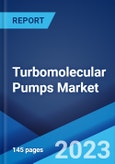Turbomolecular pumps (TMPs) are kinetic vacuum pumps comprising a fast-spinning rotor, turbine, and stationary stator discs with gas conveying channels. They are extremely easy to function, have minimal maintenance requirements, and provide a low vibration, hydrocarbon-free operation that needs no regeneration. As they can be highly compact when combined with a dry primary pump, TMPs find usage in a wide range of applications, ranging from electron microscopy to semiconductor processing. They are also used in ultra-high vacuum applications, such as analytical instruments, and harsh industrial environments wherein the pumps need to handle corrosive gases or critical process conditions.
Turbomolecular Pumps Market Trends:
The escalating demand for semiconductor equipment in the manufacturing of consumer electronics, such as tablets, laptops, and smartphones, represents one of the key factors impelling the market growth. This can also be accredited to the growing adoption of semiconductors in hybrid and electronic vehicles. Apart from this, TMPs create a vacuum environment that is indispensable in the fabrication of solar cells and silicon wafers. This, in confluence with the widespread adoption of silicon wafers in advanced driver-assistance systems (ADAS), automatic braking systems, adaptive cruise control, and touch-free human-machine interfaces in automobiles, is contributing to the market growth. Moreover, operational proficiency and enhanced productivity offered by TMPs are expanding their applications in research and development (R&D) of nuclear fusion that requires a clean ultra-high vacuum. Furthermore, the rising demand for electron microscopes, focused ion-beam systems, and surface analysis systems is impelling the market growth. Besides this, the development of smart onboard controllers that can monitor and control valves, pumps, and gauges within an automated vacuum system is anticipated to drive the market.Key Market Segmentation:
The publisher provides an analysis of the key trends in each sub-segment of the global turbomolecular pumps market report, along with forecasts at the global, regional and country level from 2023-2028. The report has categorized the market based on product and application.Breakup by Product:
- Magnetically Levitated
- Oil Lubricated
- Hybrid
Breakup by Application:
- Analytical Instrumentation
- Semiconductor
- Research and Development (R&D)
- Others
Breakup by Region:
- North America
- United States
- Canada
- Asia-Pacific
- China
- Japan
- India
- South Korea
- Australia
- Indonesia
- Others
- Europe
- Germany
- France
- United Kingdom
- Italy
- Spain
- Russia
- Others
- Latin America
- Brazil
- Mexico
- Others
- Middle East and Africa
Competitive Landscape:
The competitive landscape of the industry has also been examined along with the profiles of the key players being Agilent Technologies Inc., Atlas Copco, Busch LLC, Ebara Corporation, Elettrorava S.r.l., FMG Enterprises Inc., Ingersoll Rand Inc., KYKY Technology Co. Ltd., Osaka Vacuum Ltd., Shimadzu Corporation and ULVAC Inc.Key Questions Answered in This Report:
- How has the global turbomolecular pumps market performed so far and how will it perform in the coming years?
- What has been the impact of COVID-19 on the global turbomolecular pumps market?
- What are the key regional markets?
- What is the breakup of the market based on the product?
- What is the breakup of the market based on the application?
- What are the various stages in the value chain of the industry?
- What are the key driving factors and challenges in the industry?
- What is the structure of the global turbomolecular pumps market and who are the key players?
- What is the degree of competition in the industry?
Table of Contents
Companies Mentioned
- Agilent Technologies Inc.
- Atlas Copco
- Busch LLC
- Ebara Corporation
- Elettrorava S.r.l.
- FMG Enterprises Inc.
- Ingersoll R
- Inc.
- KYKY Technology Co. Ltd.
- Osaka Vacuum Ltd.
- Shimadzu Corporation and ULVAC Inc.
Methodology

LOADING...
Table Information
| Report Attribute | Details |
|---|---|
| No. of Pages | 145 |
| Published | September 2023 |
| Forecast Period | 2022 - 2028 |
| Estimated Market Value ( USD | $ 1.3 Billion |
| Forecasted Market Value ( USD | $ 1.9 Billion |
| Compound Annual Growth Rate | 6.5% |
| Regions Covered | Global |
| No. of Companies Mentioned | 11 |









